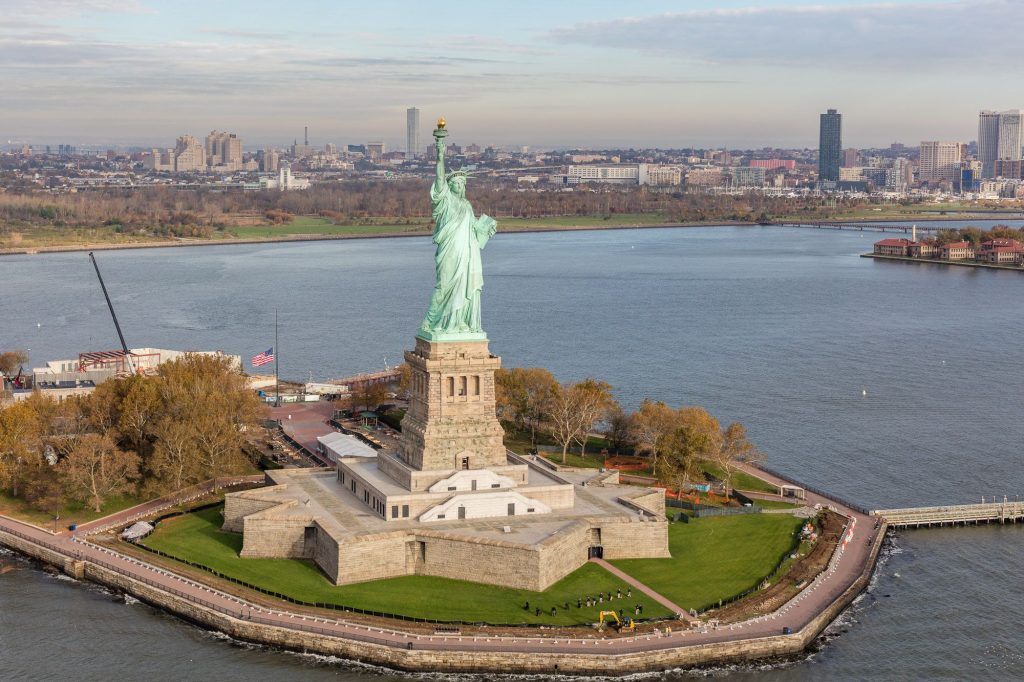At the entrance of New York Harbor, a huge bronze statue stands on Liberty Island, that is the world-famous Statue of Liberty. As a landmark building of the United States and a world-famous tourist attraction, the Statue of Liberty not only carries a profound historical background, but also embodies unique design characteristics and far-reaching significance.
The background and history of the Statue of Liberty
The Statue of Liberty, officially known as “Liberty Enlightening the World,” was a gift from France to the United States to commemorate the friendship between the two countries and their shared pursuit of the ideal of freedom. The idea for the statue was first proposed by the French thinker and historian Edouard de laboulais. In the 19th century, France decided to present the statue to the United States in order to express the growing friendship between France and the United States and to commemorate the 100th anniversary of the victory of the American Revolution.
Construction of the Statue of Liberty began in 1875 and was designed by the famous French sculptor Frederic Auguste Bartholdi. The statue, which took nearly a decade to complete, was officially completed on October 23, 1886, and inaugurated by President Grover Cleveland on October 28 of the same year. On this day, the Statue of Liberty officially becomes part of New York Harbor and welcomes visitors from all over the world.

- The design features and significance of the Statue of Liberty
The design of the Statue of Liberty is full of symbolism. The overall height of the statue is 46 meters, and the total height of the base is 93 meters. In her right hand, she held a torch, a symbol of freedom, 12 meters high, and in her left hand, she held a tablet engraved with the date of the signing of the United States Declaration of Independence. The design of the goddess’s appearance is inspired by the sculptor’s mother, and the right hand of the torch is derived from the arm of the sculptor’s wife, which makes the statue more humane and intimate.
The design of the Statue of Liberty not only reflects the ingenuity of the artists, but also carries profound symbolic significance. The torch and the tablet symbolize freedom and knowledge respectively, while the statue as a whole represents America’s pursuit and commitment to freedom. In addition, the structural design inside the statue is also full of wisdom, the entire statue is made of steel as a skeleton, and the outside is covered with copper plates, which not only ensures the stability of the statue, but also gives it an elegant appearance.
The status and influence of the Statue of Liberty in the New York City landscape
The Statue of Liberty is not only an icon of New York City, but also a global symbol of freedom and democracy. She stands at the entrance of New York Harbor and welcomes visitors from all over the world. For many people, the Statue of Liberty is not only a statue, but also a spiritual symbol, representing people’s yearning and pursuit of freedom.
In the New York City landscape, the Statue of Liberty occupies a pivotal position. She stands in stark contrast to New York’s skyscrapers, bustling streets and busy harbor, becoming an integral part of the city. Whether in films, television shows, literature and art, the Statue of Liberty is often used as a background element to symbolize New York City.
Four, the Statue of Liberty design inspiration and creative sources
The inspiration for the design of the Statue of Liberty came from many sources. First of all, the statue of Liberty, the symbol of women during the French Revolution, provides an important reference for the design of the statue. In addition, the sculptor Bartholdi was also influenced by the sculptures of ancient Greece and Rome, and these elements are reflected in the posture and dress of the statues. At the same time, the ideals of freedom, equality and human rights in the United States Declaration of Independence also provided inspiration for the design of the statue.
In modern architecture, the design elements of the Statue of Liberty still have an important influence. Many buildings draw on the elegant lines and symbolism of the Statue of Liberty when they are designed. For example, in the facade design of some modern buildings, you can see elements similar to the torch held by the Statue of Liberty. These elements are not only beautiful, but also symbolize freedom and hope.

The preservation and protection of the Statue of Liberty
As a building with important historical significance and cultural value, the preservation and protection of the Statue of Liberty is particularly important. Over time, the statue has undergone numerous repairs and maintenance works to ensure its safety and integrity. However, we still need to do more to strengthen conservation efforts and pass on this cultural heritage.
The government and all sectors of society should increase the investment in the Statue of Liberty, regular repair and maintenance work to ensure its long-term preservation. Secondly, we can enhance public awareness and protection of the Statue of Liberty by strengthening publicity and education. Related cultural activities and research projects can also be carried out to delve deeper into the Statue of Liberty’s history and culture.
The Statue of Liberty is not only a statue or a tourist attraction, but also a spiritual symbol and cultural heritage. She witnessed the historical changes and social development since the American War of Independence, and also witnessed the unremitting pursuit of freedom and democracy. We should cherish this cultural heritage and strive to pass it on for future generations to admire and learn from.
The Statue of Liberty in New York is an architectural treasure full of historical, cultural and artistic value. It not only carries a deep historical background and significance, but also embodies unique design characteristics and influences in modern architecture. As an iconic building and cultural icon, the Statue of Liberty continues to inspire people in their quest for freedom and democracy, and to be a beautiful sight in New York and around the world. We should work together to protect this cultural heritage so that future generations can continue to appreciate its unique charm and value.





















